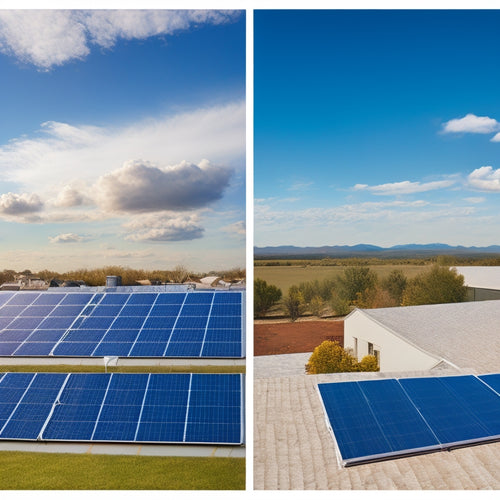
Best Batteries to Store Solar Panel Energy
Share
When storing solar panel energy, you'll want a reliable battery that meets your needs. Lithium-ion batteries stand out with their high efficiency ratings (95-98%) and long lifespan (10-15 years), making them a popular choice. However, lead-acid batteries, despite their shorter lifespan (5-7 years), are still a viable option. Other considerations include depth of discharge, installation costs, and compatibility with your existing system. By understanding these key factors, you can make an informed decision. Now, investigate the various battery types and their features to find the best fit for your solar energy storage needs.
Key Takeaways
- Lithium-Ion batteries provide the highest efficiency at 95-98% and a longer lifespan of 10-15 years, making them a top choice for solar energy storage.
- Efficiency ratings exceeding 90% are crucial to minimize energy loss during storage and retrieval, with higher ratings indicating better performance.
- Depth of Discharge (DOD) affects battery lifespan, with higher DOD allowing for more energy extraction but potentially reducing lifespan due to increased wear.
- Compatibility with existing solar panel systems and inverters is essential for seamless operation, and monitoring systems can enhance performance and efficiency tracking.
- Long-term budget and ROI considerations are crucial for making a wise investment, including factors like installation costs, maintenance, and potential electrical upgrades.
Top Battery Options for Solar
When it comes to employing solar energy, one crucial component stands out: the battery. You're looking for a reliable powerhouse that can store excess energy generated by your solar panels during the day, and release it when you need it most.
You'll want a battery that prioritizes energy efficiency, ensuring that the maximum amount of energy is stored and applied. Look for batteries with high depth-of-discharge (DOD) ratings, which indicate the percentage of the battery's capacity that can be safely used without damaging the cells. A higher DOD translates to more usable energy and a longer battery lifespan.
Some top battery options for solar energy include lithium-ion batteries, such as the Tesla Powerwall or LG Chem RESU. These batteries boast high energy efficiency, long lifetimes, and compact designs that make them ideal for residential installations.
Other options, like lead-acid batteries, offer a lower upfront cost but may require more maintenance and have shorter lifespans. Whatever your needs, it's crucial to choose a battery that aligns with your energy goals and budget.
Key Features to Consider
You've narrowed down your options to a few top battery contenders for your solar energy system, but now it's time to scrutinize their features to guarantee you're getting the best fit for your needs. When evaluating batteries, take into account the efficiency ratings, as they directly impact how much energy you can store and use. Look for batteries with high round-trip efficiency ratings (>90%) to minimize energy loss.
Another vital factor is installation costs. While the upfront cost of the battery itself is significant, take into account the additional expenses for installation, maintenance, and monitoring. Be sure to factor in the cost of any necessary upgrades to your electrical infrastructure.
Here's a summary of key features to take into account:
| Feature | Description | Impact |
|---|---|---|
| Efficiency Ratings | Measure of energy storage and retrieval efficiency | Energy savings and reduced waste |
| Installation Costs | Upfront and ongoing expenses for battery setup and maintenance | Budget and ROI considerations |
| Compatibility | Ability to integrate with existing solar panel systems and inverters | Seamless system operation and optimization |
Depth of Discharge Matters
As you investigate deeper into the features of your top battery contenders, another critical factor to examine is the depth of discharge (DOD). This refers to the percentage of a battery's capacity that's used before recharging.
You'll want to evaluate a battery's DOD because it greatly impacts its lifespan and energy efficiency. A higher DOD means more energy is extracted from the battery, but it also increases wear and tear, reducing the number of discharge cycles it can handle.
A battery with a higher DOD may seem appealing, but it's crucial to weigh the benefits against the potential drawbacks. For instance, a battery with an 80% DOD may provide more usable energy, but it may only last for 3,000 to 5,000 discharge cycles.
On the other hand, a battery with a 50% DOD may have a longer lifespan, with 7,000 to 10,000 discharge cycles, but it will provide less usable energy.
When selecting a battery, you'll need to find a balance between energy efficiency and lifespan to guarantee your solar panel energy storage system meets your power needs.
Battery Capacity and Size
Your solar panel energy storage system's performance relies heavily on the battery capacity and size you choose. The capacity of your battery determines how much energy it can store, while the size affects its physical footprint and installation requirements.
When selecting a battery, consider the following factors to guarantee peak performance and energy efficiency:
-
Calculating your energy needs: Determine how much energy you need to store based on your daily consumption and the size of your solar panel array.
-
Battery lifespan: Choose a battery with a long lifespan to minimize replacement costs and guarantee consistent performance over time.
-
Depth of discharge: Select a battery with a high depth of discharge to maximize energy storage and reduce waste.
-
Energy efficiency: Opt for a battery with high energy efficiency to minimize energy loss during charging and discharging.
-
Scalability: Consider a battery that can be scaled up or down depending on your changing energy needs.
Types of Solar Batteries
The market offers various types of solar batteries, each with its unique characteristics, advantages, and limitations. When selecting a solar battery, you need to reflect on factors such as energy storage efficiency, depth of discharge, and lifespan. Different solar battery technologies cater to specific needs and applications.
| Solar Battery Type | Energy Storage Efficiency |
|---|---|
| Lead-Acid | 80-90% |
| Nickel-Cadmium (Ni-Cd) | 90-95% |
| Nickel-Metal Hydride (NiMH) | 92-95% |
| Lithium-Ion (Li-ion) | 95-98% |
You'll notice that Lithium-Ion batteries have the highest energy storage efficiency, making them a popular choice for many solar energy systems. However, they can be more expensive than other options. Lead-Acid batteries, on the other hand, are more affordable but have lower energy storage efficiency. As you investigate different solar battery technologies, reflect on your energy needs, budget, and environmental concerns to make an informed decision.
Lithium-Ion Battery Advantages
Lithium-Ion batteries' high energy storage efficiency is just one of their many advantages, making them a sought-after choice for solar energy systems.
When you opt for lithium-ion batteries, you can expect a significant reduction in energy losses, ensuring that most of the solar power generated is stored and available for use.
Some of the key benefits of lithium-ion batteries include:
- High lithium ion efficiency, with a discharge rate of up to 95%
- Long lithium ion longevity, with a lifespan of 10-15 years or more
- Low self-discharge rate, meaning they retain their charge even when not in use
- High depth of discharge (DOD), allowing for deeper cycling and increased overall capacity
- Compact design and lightweight construction, making them ideal for a range of applications
Lead-Acid Battery Drawbacks
When evaluating your options for solar energy storage, you'll want to weigh the limitations of lead-acid batteries against their benefits. One major drawback is their environmental impact. Lead-acid batteries contain toxic materials that can contaminate soil and water if not disposed of properly.
Additionally, the lead used in these batteries is often sourced from mining operations that can harm local ecosystems.
In terms of performance, lead-acid batteries have a relatively short lifespan compared to other options. They typically last between 5-7 years, which means you'll need to replace them more frequently. This can increase your overall costs and reduce the overall efficiency of your solar energy system.
When making a lifespan comparison, it's crucial to evaluate the number of charge cycles a battery can handle. Lead-acid batteries typically max out at around 500-700 cycles, which is considerably lower than other battery types.
This limited capacity can lead to reduced energy storage and increased maintenance needs over time.
Maintenance and Warranty Support
You'll also want to factor in the maintenance and warranty support when evaluating lead-acid batteries for your solar energy system. This aspect is vital to guarantee your batteries operate at peak levels and prolong their lifespan.
When it comes to maintenance, lead-acid batteries require regular checks to confirm they're functioning correctly.
Some essential maintenance and warranty considerations include:
-
Regular watering: Check the electrolyte levels and top them off as needed to maintain the recommended levels.
-
Equalization charging: Perform equalization charging every 1-3 months to prevent sulfation and ensure all cells are balanced.
-
Monitoring temperature: Keep an eye on the battery temperature, as high temperatures can reduce battery longevity.
-
Cycle counting: Track the number of charging cycles to determine when it's time to replace the batteries.
-
Warranty coverage: Look for manufacturers that offer thorough warranties, typically 2-5 years, to protect your investment.
Frequently Asked Questions
Can I Mix Old and New Batteries in My Solar Panel System?
You shouldn't mix old and new batteries in your solar panel system, as it can lead to battery compatibility issues and performance differences, reducing overall efficiency and lifespan, and potentially causing system failures.
Do I Need a Charge Controller for My Solar Battery Setup?
You'll need a charge controller to regulate voltage and prevent overcharging, ensuring your solar battery setup operates efficiently. Consider MPPT or PWM controller types to optimize solar energy efficiency, maximizing your power output.
Can I Charge My Electric Vehicle With My Solar Battery?
When you're stuck in traffic, imagine utilizing the sun's energy to fuel your escape. You can charge your electric vehicle with your solar battery, ensuring a seamless, sustainable ride, as long as your solar battery charging setup is compatible with your electric vehicle's requirements.
Are Solar Batteries Affected by Extreme Temperatures?
You're right to wonder if temperature affects your solar battery's performance. Temperature extremes can impact battery longevity; high temps can reduce capacity, while low temps can slow charging. Look for batteries with built-in thermal management to mitigate these temperature effects.
Can I Use a Generator to Charge My Solar Battery Backup?
You're the ruler of your off-grid kingdom, and you're wondering if a generator can be the trusty knight that charges your solar battery backup. Yes, you can use a solar generator or hybrid systems to charge your batteries, but it's essential to verify compatibility and ideal configuration.
Related Posts
-

Charging Points in Rural Areas: 5 Key Insights
When driving through rural areas, you'll face a shortage of charging points, making EV ownership stressful and inconv...
-

What Role Do Unicycles Play in Urban Transport?
As you navigate through congested city streets, unicycles emerge as a viable solution, slashing carbon emissions by u...
-

Tracking Solar Panels Vs Fixed Panels Cost Savings
When considering solar panel options, you'll want to weigh the cost savings of tracking solar panels versus fixed pan...


